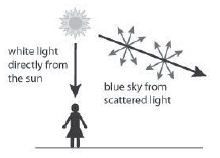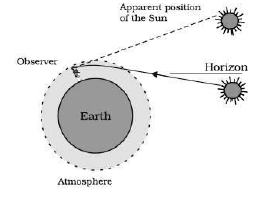Students should refer to Light ICSE Class 10 Physics Board Exam Questions provided below with solutions. These will help the students to understand the type of questions which have been asked in previous year examinations and the type of solutions which the student should give to get good marks. You should also refer to ICSE Class 10 Physics Sample papers for more practice
ICSE Class 10 Physics Light Important Questions
Students should learn the important questions and answers given below for Chapter Light in Physics for ICSE Class 10. These board questions are expected to come in the upcoming exams. Students of ICSE Class 10th should go through the Important questions and answers ICSE Class 10 Physics which will help them to get more marks in exams.
Light ICSE Class 10 Physics Board Exam Questions
Light ICSE Class 10 Physics Board Exam Questions
1) Why does the sun appear reddish early in the morning?
Answer:
In the early morning, the sun is near the horizon. The light has to travel through a thicker layer of air and longer distance in the earth’s atmosphere. Hence blue light and shorter wavelengths are scattered away by the particles in the earth’s atmosphere before reaching our eyes. Hence the light of longer wavelengths reaches our eyes which give rise to the reddish appearance of the sun.

2) Why does the sky appear dark instead of blue to the passengers at very high altitudes or to an astronaut?
Answer:
When sunlight passes through the atmosphere, the fine particles in the air scatter the blue colour (shorter wavelength) more strongly than red. The scattered blue light enters our eyes. If the earth had no atmosphere there would not have been any scattering and the sky would have looked dark. This is why the sky appears dark to passengers flying at very
high altitudes or to an astronaut.
3) Why are the danger signals red?
Answer:
Red colour is used in danger signals as the red light is scattered the least by air molecules. The scattering of light is found to be inversely proportional to the fourth power of the wavelength of light. Thus scattering of red light is very much less than that of yellow light. Therefore red light signals can be seen up to a longer distance. This is why danger signals are red.
4) Why do people prefer light coloured dresses during summer and dark dresses during winter?
Answer:
White coloured clothes reflect almost all the light incident on it while black clothes absorb all the light rays incident on it which is converted into heat. This is why people prefer
dark coloured dresses in winter to keep warm.
5) Why do the clouds appear white?
Answer:
Dust particles and water droplets present in the atmosphere do not obey Rayleigh’s scattering law. They scatter all the colours almost equally. Since light travels as waves of
different lengths, each color has its very own unique wavelength. Clouds are white because their water droplets or ice crystals are large enough to scatter the light of the seven
wavelengths (red, orange, yellow, green, blue, indigo, and violet), which combine to produce white light. Thus the clouds appear white.
6) Why does the sky appear blue?
Answer:
The scattering of light depends on the wavelength of light. The wavelength of violet colour so the blue colour is scattered more than the red colour. Due to scattering of blue light in different directions, the sky appears blue.

7) Why do the stars show the twinkling effect whereas the planets do not?
Answer:
The light from stars suffers a series of refraction due to atmospheric layers of different densities and different refractive indices as they are very far from earth. Due to this reason, a ray of light starting from a star say ‘S’ bends more and more towards the normal before reaching the observer on the earth. But the observer sees the star in the direction of the ray reaching finally in the eye, so the star appears to him at S 1 instead of the actual position which is at S.
On account of change in temperature and density the apparent position of the star continuously changes which gives the twinkling effect to the star.
But the planets do not twinkle because they are nearer to the earth and subtend a greater angle at the eye. Hence the amount of light received from them is much larger than the stars.
Therefore, the change in their position and brightness is not noticeable.
8) During sunset and sunrise, the sun is seen even when it is slightly below the horizon. Explain?
Answer:
This is known as the collective phenomena of advanced sunrise and delayed sunset. Which means that when the light coming from the sun enters the earth’s atmosphere it suffers refraction from rarer to denser layers up to the earth. Therefore, it bends towards the normal at successive refractions but to the observer on the earth, it appears to be coming from a straight line path above the horizon.
So it is seen above the horizon while actually, it is below the horizon due to refraction of light through the layers of the atmosphere. Similarly, at the time of sunset, it actually sets, i.e.,
goes down below the horizon but appears above the horizon.

Atmospheric refraction effects at sunrise and sunset




